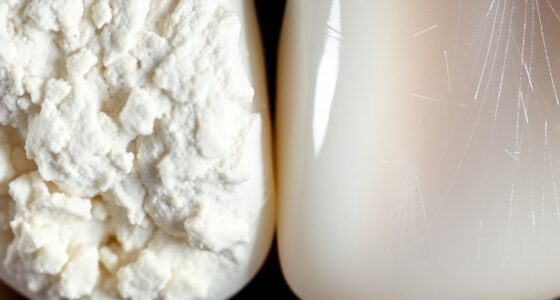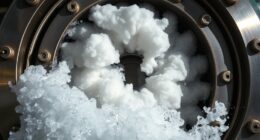Using harsh chemicals or aggressive scrubbing can weaken or damage your filter media, shortening its lifespan. Skipping thorough rinsing or reusing damaged filters increases the risk of dirt buildup, contamination, and early failure. Cleaning too often or not enough, along with applying excessive force or ignoring manufacturer guidelines, also hasten wear. Ensuring proper inspection, drying, and following recommended maintenance schedules helps extend filter life. Keep these mistakes in mind to maximize filter performance and lifespan.
Key Takeaways
- Using harsh chemicals or aggressive cleaning methods can weaken or damage filter media, reducing lifespan.
- Insufficient rinsing leaves residues that clog the filter and impair performance.
- Cleaning filters too frequently or not often enough accelerates wear or causes buildup, shortening filter life.
- Applying excessive force during cleaning risks tearing or cracking delicate filter components.
- Ignoring manufacturer cleaning guidelines may lead to improper maintenance and early filter failure.
Using Harsh Cleaning Agents That Damage the Filter Media
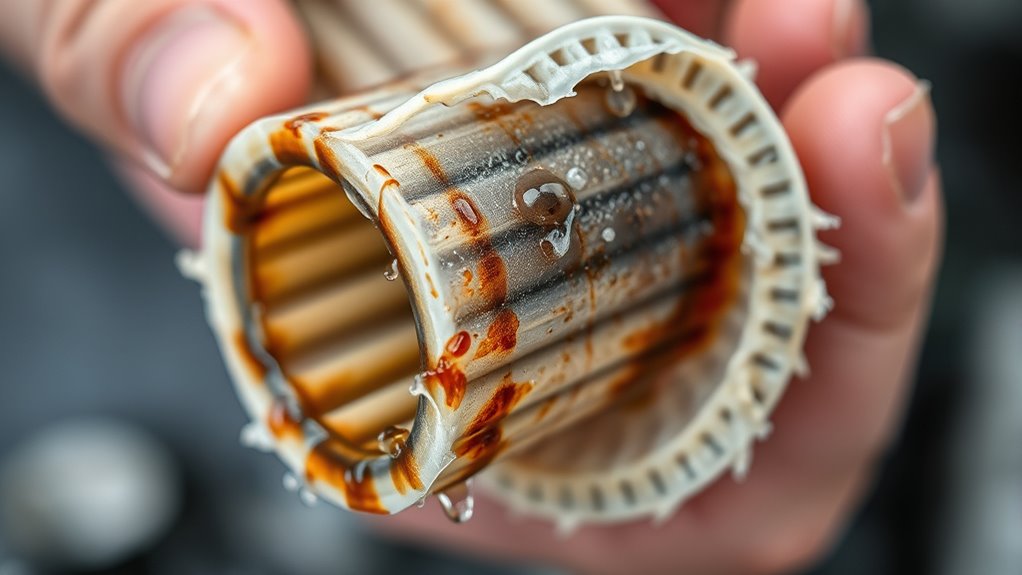
Many people mistakenly believe that using strong cleaning agents will quickly restore their cartridge filters, but in reality, harsh chemicals can weaken or destroy the filter media. These aggressive cleaners may seem effective at removing dirt and algae, but they often compromise the filter’s integrity. The chemicals can break down the fibers or media material, reducing the filter’s ability to trap debris effectively. Over time, this damage results in decreased filtration efficiency and shorter filter lifespan. Instead of relying on aggressive cleaners, opt for gentle, manufacturer-approved solutions. Regular rinsing with clean water and avoiding harsh substances will help preserve the filter’s structure. Additionally, proper maintenance practices can prevent unnecessary damage and extend the life of your filters. Remember, protecting your filter media guarantees it continues to perform well and lasts longer.
Neglecting to Rinse Thoroughly Before Reinstallation
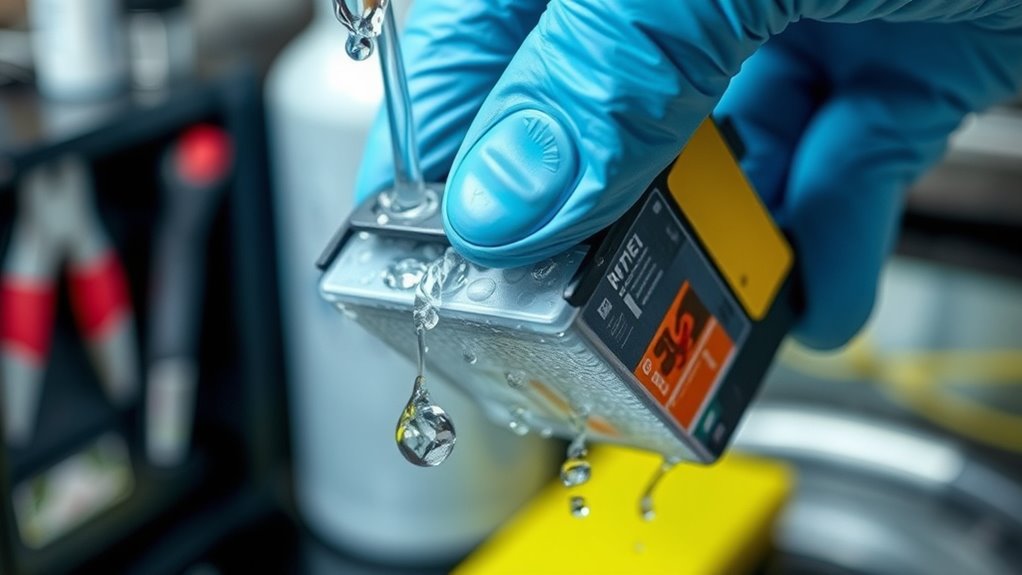
Failing to rinse your cartridge filter thoroughly before reinstalling it can lead to lingering dirt, debris, and cleaning residues that compromise its performance. If you leave behind dirt or soap residue, it can clog the media faster, reducing flow and filtration efficiency. Residues may also create a breeding ground for bacteria, leading to algae growth and foul odors. Inadequate rinsing can cause the filter to work harder, increasing wear and shortening its lifespan. It’s essential to spend enough time rinsing the cartridge until the water runs clear, ensuring all debris and cleaning agents are removed. This step helps maintain suitable filtration, saves energy, and prolongs the life of your filter. Proper filter maintenance is key to avoiding these issues and ensuring optimal water quality. Skipping or rushing this process can cause costly replacements and decreased water quality.
Cleaning Filters Too Frequently or Not Often Enough

Cleaning filters too often can wear them out faster, leading to costly replacements, while not cleaning enough lets debris build up and harms your equipment’s performance. Both mistakes can reduce your system’s lifespan and efficiency. Finding the right balance is key to maintaining clean filters without causing damage. Regular inspection and understanding filter maintenance needs can help prevent these common pitfalls.
Overcleaning Risks
Cleaning filters too often can wear them out prematurely, reducing their effectiveness and potentially causing you to spend more on replacements. Overcleaning can damage the filter media, leading to tears or thinning that diminishes its ability to trap particles. When filters are cleaned excessively, they may also lose their structural integrity, which increases the risk of leaks or failure. Additionally, cleaning too frequently can cause unnecessary wear on equipment, wasting time and resources. Neglecting to clean filters often enough can allow dirt buildup, impairing system performance. Finding a balance is key. Follow manufacturer guidelines for cleaning intervals, and avoid the temptation to clean just because the filter looks dirty. Proper timing preserves filter life and maintains ideal system efficiency. Understanding filter materials can help you better assess when cleaning is necessary and prevent damage.
Under-cleaning Consequences
When filters are neglected or cleaned too often, system performance can suffer considerably. Under-cleaning allows dirt and debris to build up, reducing airflow and causing strain on your equipment. This can lead to decreased efficiency and higher energy costs. Conversely, cleaning filters too infrequently causes clogging, which forces your system to work harder and shortens filter lifespan. Here are the key consequences:
- Reduced airflow, leading to poor system performance
- Increased energy consumption and costs
- Faster wear and tear on system components
- Shortened filter life, requiring more frequent replacements
Balancing cleaning schedules is essential. Neglecting or over-cleaning can both damage your system and increase expenses over time. Proper maintenance ensures peak performance and longevity. Regular inspections and understanding the importance of filter lifespan can help prevent these issues before they arise.
Applying Excessive Force During Cleaning
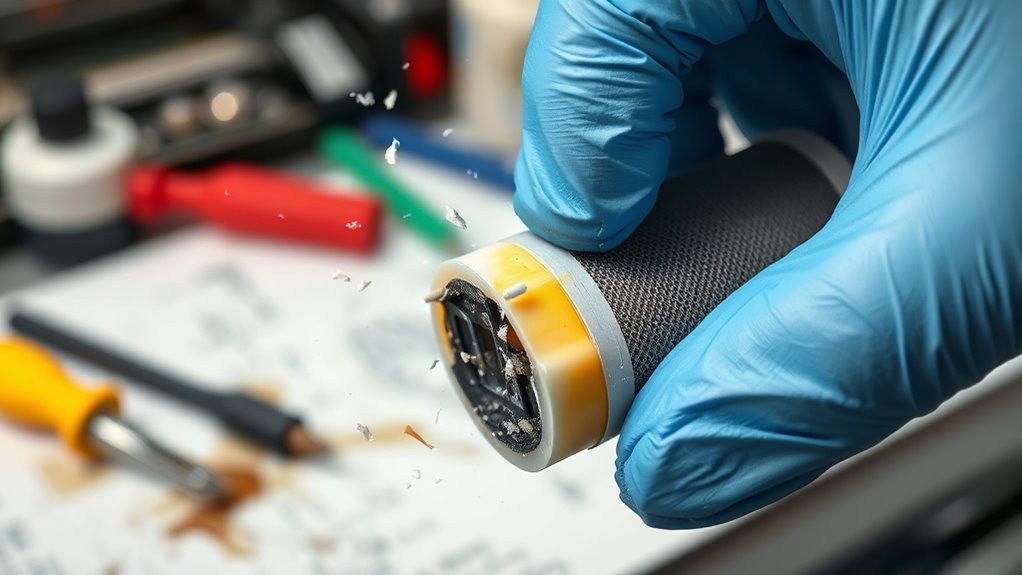
Applying excessive force during cartridge cleaning can seem like a quick fix, but it often causes more harm than good. When you push too hard, you risk damaging delicate filter components or dislodging essential parts. This can lead to tears, cracks, or misalignments that compromise the filter’s integrity. Overly aggressive scrubbing or forcing dirt loose may also remove protective coatings, making the filter more vulnerable to damage during future use. Additionally, applying too much pressure can cause unnecessary wear, shortening the lifespan of your cartridge. Instead, focus on gentle cleaning methods that effectively remove debris without stressing the filter material. Proper technique preserves the filter’s condition and ensures it continues functioning efficiently without premature failure. Using proper cleaning techniques helps maintain the filter’s durability and performance over time.
Ignoring Manufacturer’s Cleaning Guidelines

Ignoring your manufacturer’s cleaning instructions can lead to damage or poor performance. You might use the wrong cleaning agents or skip recommended maintenance intervals, which can cause costly issues. Always follow the guidelines to keep your cartridge functioning properly and avoid unnecessary mistakes. Proper maintenance can also help prevent buildup that might interfere with the cartridge’s performance and longevity exfoliation benefits.
Overlooking Specific Instructions
Neglecting to follow the manufacturer’s cleaning instructions can lead to serious damage to your cartridge. Ignoring these specific guidelines may cause parts to break or become misaligned, reducing filter effectiveness. To avoid this, pay close attention to the details provided.
Here are four common pitfalls:
- Skipping recommended cleaning steps or sequences.
- Using incorrect tools that can damage delicate components.
- Over-cleaning or under-cleaning, which affects performance.
- Ignoring recommended drying times before reassembling.
Using Wrong Cleaning Agents
Using the wrong cleaning agents can cause immediate damage to your cartridge’s components, even if you follow other procedures correctly. Harsh chemicals, abrasives, or incompatible solutions can corrode or weaken seals, membranes, and filters. For example, using alcohol-based cleaners on certain filters may cause them to degrade faster, reducing their effectiveness. Some agents might leave residues that clog passages or interfere with proper filtration. Always check the manufacturer’s guidelines before selecting a cleaning solution. Using an improper agent not only risks damaging your cartridge but can also lead to costly replacements or decreased filter performance. Stick to recommended cleaning agents to ensure your cartridge remains in excellent condition and maintains its lifespan. Ignoring these guidelines can short-circuit your efforts and shorten filter life. Additionally, security vulnerabilities in some cleaning processes could expose your system to risks if not properly managed.
Ignoring Maintenance Frequency
Have you ever overlooked how often your cartridge needs cleaning? Ignoring the manufacturer’s guidelines can lead to premature wear and filter failure. To prevent this, stick to these key points:
- Check the recommended cleaning schedule regularly.
- Clean more frequently if your system handles heavy or dirty fluids.
- Don’t wait until filters are visibly clogged; regular maintenance is essential.
- Record cleaning dates to stay on top of routine schedules.
- Consider your ambient light conditions to determine if more frequent cleaning is necessary.
Skipping these steps can cause buildup, reduce filter efficiency, and shorten its lifespan. By following the manufacturer’s suggested frequency, you guarantee your cartridge performs at its best longer. Neglecting this simple step might save time initially but will cost you more in replacements and repairs later. Stay proactive, and your filters will reward you with better performance and longevity.
Using Hot Water When Cold Water Is Recommended

Although hot water might seem like a quick way to clean your cartridge, experts recommend sticking to cold water because it’s gentler on the components. Hot water can cause certain parts, like the filter media and seals, to warp or degrade. This weakening shortens the lifespan of your cartridge and reduces its effectiveness. Cold water effectively loosens dirt and debris without risking damage. Additionally, hot water can cause mineral deposits to set in, making cleaning less efficient over time. Using cold water also prevents the expansion of delicate parts, maintaining the integrity of your filter. Moreover, AI safety measures are essential to ensure that automated cleaning technologies do not inadvertently cause damage. Remember, gentle cleaning preserves your cartridge’s functionality and extends its life, so resist the temptation to use hot water—even if it seems faster or easier.
Reusing Discarded or Damaged Filters

Reusing filters that are damaged or discarded can lead to serious risks, including contamination and decreased filtration efficiency. Cleaning methods might seem effective, but they can cause further damage and compromise the filter’s integrity. Before attempting repairs, consider whether the filter will truly perform well afterward or if it’s better to replace it entirely.
Risks of Reusing Filters
Using discarded or damaged filters can pose serious risks because they often no longer effectively trap contaminants, allowing dirt and debris to circulate through your system. Reusing these filters can lead to equipment damage, increased maintenance costs, and compromised air quality.
Here are some key risks:
- Reduced filtration efficiency, letting harmful particles pass through.
- Blockages that restrict airflow and strain your system.
- Contamination buildup, which can cause mold or bacteria growth.
- Shortened filter lifespan, forcing you to replace filters more frequently.
Reusing damaged or discarded filters might seem cost-effective initially, but it ultimately compromises your system’s performance and safety. Always inspect filters carefully and replace them when damaged or worn out to avoid these serious consequences.
Damage From Cleaning Methods
Cleaning discarded or damaged filters without proper techniques can cause more harm than good. Using harsh chemicals or abrasive scrubbing can weaken the filter media, leading to tears or holes that allow contaminants to bypass filtration. High-pressure washing might seem effective but can deform or dislodge delicate components, reducing filter integrity. Attempting to reuse filters with visible damage risks spreading contaminants rather than removing them. Improper cleaning methods may also strip away protective coatings, accelerating deterioration. If you ignore manufacturer guidelines or use incompatible cleaning agents, you could unintentionally compromise the filter’s structure. Always inspect filters carefully before cleaning and follow recommended procedures. Otherwise, you risk rendering the filter useless or causing damage that shortens its lifespan, which defeats the purpose of cleaning altogether.
Effectiveness After Repair
Even when repairs are attempted on discarded or damaged filters, their effectiveness often remains compromised. You might think a quick fix restores full performance, but that’s rarely the case. Repaired filters tend to lose their original filtration capacity, making them less effective at trapping contaminants.
Consider these points:
- The structural integrity may be weakened, allowing particles to bypass the filter.
- Residual damage can create gaps, reducing filtration efficiency.
- Repaired filters often have a shorter lifespan, requiring more frequent replacements.
- Contaminants trapped before repair may still be present, risking recontamination.
Ultimately, reusing damaged filters can give a false sense of security and lead to higher costs or equipment failure. It’s better to replace filters for maximum performance.
Not Allowing the Filter to Fully Dry Before Reuse
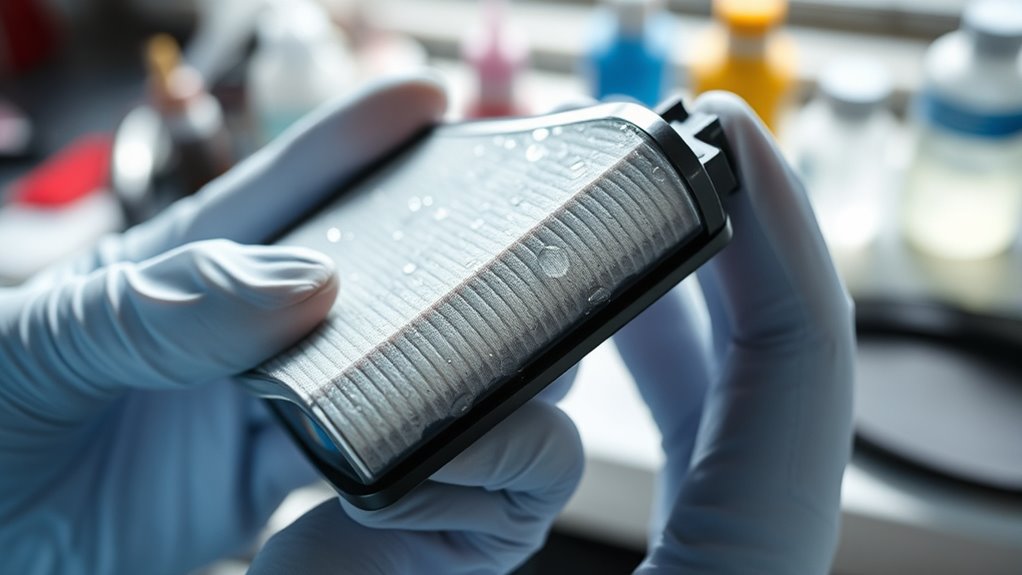
If you don’t let the filter fully dry before reusing it, you risk trapping moisture inside, which can lead to mold growth and reduce the filter’s effectiveness. Moisture creates the perfect environment for bacteria and mold to thrive, compromising the air quality and potentially causing health issues. Reusing a damp filter also shortens its lifespan, as residual moisture can cause material breakdown and clogging. To avoid this, give the filter ample time to air dry in a well-ventilated area before reinstalling. Rushing this step can undo your cleaning efforts and lead to costly replacements sooner than expected. Patience is key—allowing the filter to dry completely ensures it performs efficiently and extends its functional life.
Overlooking the Importance of Proper Inspection and Replacement
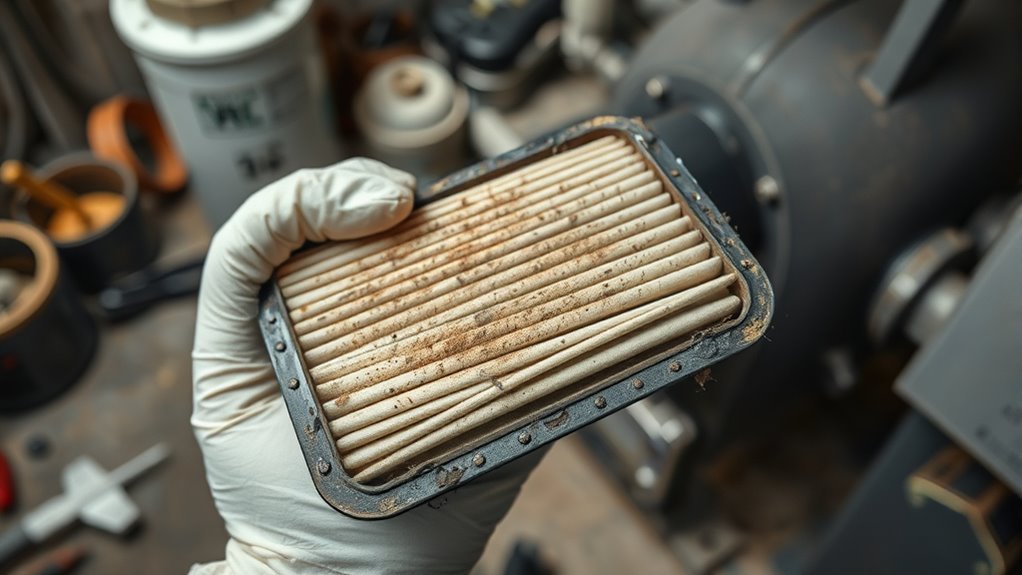
Neglecting to regularly inspect your filter and recognize when it needs replacement can substantially diminish its effectiveness. Without proper checks, you might keep a filter that’s worn out or clogged, reducing flow and filtration quality. To avoid this, consider these key steps:
- Check for visible dirt, damage, or wear that indicates replacement is necessary.
- Monitor pressure gauges or indicators that signal filter clogging.
- Follow manufacturer guidelines for inspection intervals.
- Replace filters promptly once they show signs of reduced performance.
Ignoring these steps can lead to decreased filtration, increased system strain, and costly repairs. Regular inspection ensures your filter operates at peak efficiency, saving money and extending its lifespan. Don’t overlook the importance of timely inspection and replacement to maintain ideal system performance.
Failing to Regularly Monitor Filter Performance and Condition
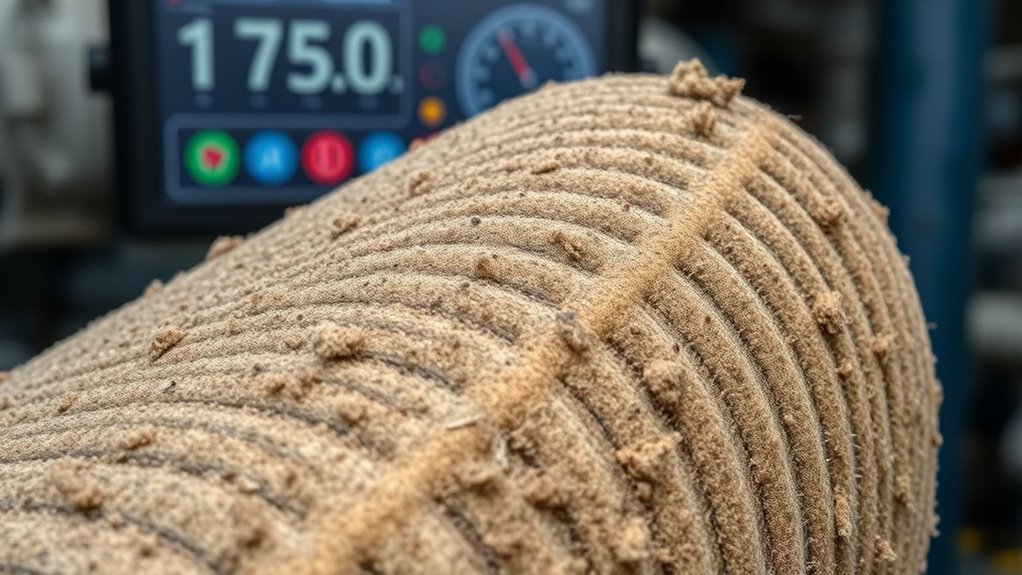
Regularly monitoring your filter’s performance and condition is essential to guarantee it functions effectively. Without this, you risk undetected clogs, reduced flow, or damage that shortens filter life. Keep an eye on pressure gauges, flow rates, and visual signs like discoloration or debris buildup. To visualize, consider this table:
| Filter Condition | Performance Indicators | Maintenance Action |
|---|---|---|
| Clean and Clear | Normal flow, no leaks | Regular checkups |
| Slight Buildup | Slight pressure increase | Schedule cleaning |
| Heavy Clogging | Reduced flow, high pressure | Replace or deep clean |
| Damage or Wear | Visible cracks or tears | Replace immediately |
Monitoring helps you catch issues early, saving money and extending filter lifespan. Ignoring performance means risking costly failures.
Frequently Asked Questions
How Can I Tell if My Filter Needs Immediate Replacement?
You can tell if your filter needs immediate replacement by checking for reduced airflow or water pressure, which indicates clogging. Also, look for visible debris or discoloration on the filter surface. If cleaning doesn’t restore performance or if you notice a persistent bad odor, it’s time to replace the filter. Regular inspection and monitoring filter effectiveness help prevent damage and ensure ideal filtration.
What Are the Signs of a Filter Damaged by Improper Cleaning?
If your filter is damaged from improper cleaning, you’ll notice decreased airflow, unusual noises, or persistent odors. You might see visible cracks, tears, or deformation on the filter material. Additionally, the filter may become overly dirty quickly, indicating it’s not functioning properly. These signs mean you should replace the filter promptly to maintain your system’s efficiency and prevent further damage. Regular inspection helps catch issues early.
Are There Eco-Friendly Cleaning Options for Filters?
Back in the day, eco-friendly cleaning options for filters include using biodegradable soaps or vinegar solutions. You can opt for natural detergents that break down dirt without harming the environment. Avoid harsh chemicals like bleach or synthetic cleaners, which can damage the filter material and harm ecosystems. Regularly rinsing with water and using gentle, plant-based cleansers help extend your filter’s life while keeping your system green and clean.
How Often Should Filter Performance Be Checked?
You should check your filter’s performance at least once a month to guarantee it’s working efficiently. Regular inspections help you catch any buildup or damage early, preventing reduced airflow or system strain. If you notice decreased performance or increased noise, check the filter more frequently. Keeping an eye on performance helps extend the filter’s lifespan and maintains ideal system operation, saving you money and energy in the long run.
Can Improper Cleaning Affect Filter Warranty Coverage?
Did you know that improper cleaning can void up to 30% of filter warranties? If you don’t follow the manufacturer’s cleaning instructions, you risk damaging the filter and losing warranty coverage. It’s essential to use correct methods and cleaning agents. When you neglect proper cleaning, you not only shorten filter life but also jeopardize your warranty, leading to costly replacements. Always adhere to recommended cleaning procedures to protect your investment.
Conclusion
If you keep making these mistakes, your filter’s life will shrink faster than a snowman in a heatwave! Neglect proper cleaning or use harsh chemicals, and you’ll be replacing filters so often you’ll think you’re running a filter factory. Follow the manufacturer’s guidelines, rinse thoroughly, and inspect regularly—don’t let careless errors turn your filter into a useless, worn-out mess. Protect your investment and keep your system running smoothly—don’t let small mistakes cause giant headaches!


